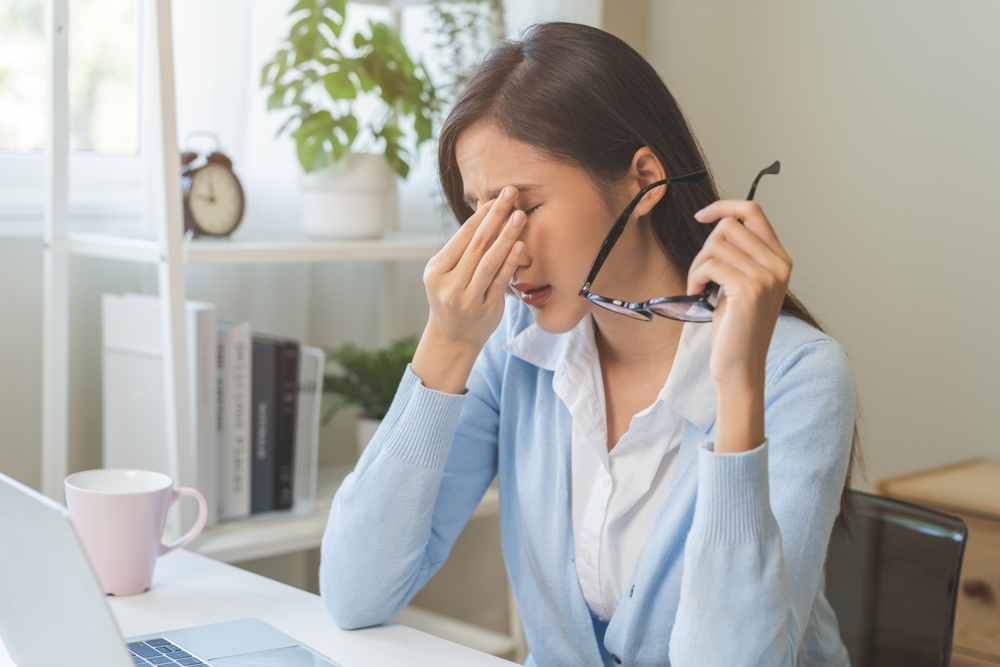
When we think about maintaining our health, we often overlook eye health. Yet, the burning, itching, and irritating sensation of dry eyes serve as an uncomfortable reminder.
Dry eyes, a condition where the eyes do not produce enough tears or the right quality of tears, can cause undue discomfort. In a world increasingly defined by screen usage, dry eyes are becoming increasingly prevalent, affecting people of all age groups. A multitude of factors, from environmental aspects, personal habits, and medical conditions, may be responsible.
What are Dry Eyes?
Dry eyes, clinically known as Keratoconjunctivitis Sicca (KCS), occur when your eyes don't produce enough tears for adequate lubrication or the tears evaporate too quickly. This lack of proper moisture and lubrication can lead to discomfort, vision issues, and tear film instability, potentially damaging the surface of the eyes.
Tears aren't just for crying—they are a crucial component of visual health. They help clear the eyes of dust and foreign matter, provide necessary lubrication, and ensure a smooth refractive surface for your vision. Each time you blink, a fresh layer of tears, made up of oil, water, and mucus, spreads across the surface of your eyes.
The tear film consists of three layers:
● Lipid Layer: This topmost layer keeps the surface of the tear film smooth and prevents evaporation of the middle watery layer.
● Aqueous Layer: This middle layer makes up the majority of our tears and helps to maintain eye hydration.
● Mucin Layer: This bottom layer spreads tears evenly over the eye and ensures eye surface contact.
Dry eye can often be a chronic condition, particularly in older people. It's estimated that up to 33% of people over 50 experience symptoms of dry eye, with women being twice as likely as men.
Various environmental, physiological, and medical factors may contribute to either an inadequate amount of tears or tear evaporation, causing dry eyes. These factors include age, gender, diet, lifestyle, certain medical conditions, and side effects of particular medications.
Symptoms of Dry Eyes
Dry eyes can present with a variety of symptoms. The most common symptom associated with dry eyes is persistent dryness, but others include:
● Excessive tearing followed by periods of dryness
● Burning or stinging sensation
● Redness
● The feeling of something in the eye (foreign body sensation)
● Blurred vision or eye fatigue
● Sensitivity to light
People with dry eyes might also have difficulty performing tasks like reading, driving, or working on a computer for extended periods.
Risk Factors for Dry Eyes
Multiple risk factors contribute to the development of dry eyes, including:
● Age: Dry eyes affect up to 30% of adults aged 50 and older
● Gender: Women are more likely to develop dry eyes due to hormonal changes during pregnancy and menopause
● Medical Conditions: Conditions such as Sjögren's syndrome, rheumatoid arthritis, diabetes, and thyroid disorders can increase the risk of dry eyes
● Environmental Conditions: Exposure to smoke, wind, or dry climates can increase tear evaporation leading to dry eyes
● Prolonged Use of Electronic Devices: Extended use of computer screens or electronic devices can reduce blinking and may cause dry eyes
● Contact Lens Use: Long-term use of contact lenses can lead to dry eyes
Diagnosis of Dry Eyes
Diagnosis of dry eye disease is based on patient-reported symptoms and an eye examination.
The doctor may look for:
● Abnormal tear production: Special dyes are placed on the eye to determine the tear-break-up time and observe the tear production.
● Examination of the eye surface and eyelids: Looking at the eye using magnification can help determine the severity of the condition.
● Measurement of tear volume: Devices or procedures (like the Schirmer's test) can collect and measure tear volume.
Overall, dry eyes are a common but often overlooked condition. Proper diagnosis and treatment can effectively control the condition and improve quality of life.
Preventing Dry Eyes
Preventing dry eyes begins with understanding and mitigating the various risk factors contributing to the condition.
Environmental Factors
Humidifiers: Dry, dusty, and windy atmospheric conditions can exacerbate dry eyes, making your eyes feel uncomfortable. A humidifier can regulate indoor humidity levels, which often helps in ensuring your eyes stay moist. This simple step can make a significant difference, especially if you spend a lot of time in air-conditioned or heated rooms.
Avoiding Air Vents and Fans: Direct exposure to fast-moving air from fans or vents can heighten dryness. If possible, it's best to limit your exposure or protect your eyes when faced with such conditions.
Wearing Protective Eyewear: Sunglasses, particularly wrap-around styles that limit air exposure, can protect your eyes from harmful UV rays and harsh wind.
Lifestyle Habits
Diet and Hydration: Adequate fluid intake may help reduce the risk of dry eyes. Foods rich in omega-3 fatty acids, such as salmon and flaxseed, could also help improve eye lubrication.
Blinking Exercises: Proactively blinking can minimize dryness. When we stare at screens, our blink rate significantly decreases, leading to increased dryness. Setting timers or reminders to blink regularly can help combat this issue.
Reducing Screen Time: Limit the amount of time spent staring at digital screens. The 20-20-20 rule has been recommended by optometrists to help relax the visual system and prevent dryness — every 20 minutes, look at something 20 feet away for 20 seconds.
Eye Care Practices
Regular Eye Exams: Regular eye exams can help catch early signs of dry eyes, allowing for timely intervention. Importantly, it is estimated that over 16 million Americans had dry eye syndrome in 2016, showing the significance of this issue.
Proper Contact Lens Care: Contact lenses can contribute to dry eyes if not used properly. Ensuring that you frequently clean and use lubricating drops can help keep your eyes hydrated.
Taking Breaks from Screen Usage: Regular breaks from continuous screen usage can also help to prevent dry eyes. Studies have associated prolonged screen time with increased issues relating to eye dryness; therefore, it's essential to take periodic breaks to rest your eyes.
Treating Dry Eyes
For those already afflicted with dry eyes, there are several treatment options available, with a range of effectiveness dependent on the underlying cause and severity of the condition.
Over-the-counter Solutions
Artificial Tears: As a first-line treatment, artificial tears can help substitute the natural moisture.
Several brands cater to different levels of dryness. Usage is common, with an estimated 17% of people affected using artificial tears to alleviate symptoms.
Lubricating Eye Ointments: These thicker, longer-lasting products offer relief but may temporarily blur your vision. Hence, it's best to use them before bed.
Prescription Treatments
Anti-inflammatory Eye Drops: For moderate to severe dry eyes, your doctor might prescribe steroid eye drops to combat inflammation and promote tear production. These have been particularly effective in treating dry eyes related to Sjogren's syndrome.
Punctal Plugs and Eye Inserts: These treatments stop or slow down tear drainage, keeping your eyes lubricated longer. Punctal plugs are used by about 25% of current dry eye patients, indicating their widespread acceptance.
Home Remedies
Warm Compresses: Applying a warm compress to your eyes can unclog oil glands, promoting tear production. A study has shown that more than 85% of dry eye cases have a component of Meibomian gland dysfunction, making this a vital aspect of treatment.
Omega-3 Supplements: These supplements can help improve the quality of your tears, enhancing eye lubrication. Research shows that oral omega-3 supplements can decrease symptoms of eye dryness.
Eyelid Hygiene and Massage: Regularly cleaning your eyelid edges and massaging your eyelids can stimulate tear production and keep your eyes hydrated. According to the American Academy of Ophthalmology, practicing good eyelid hygiene can significantly alleviate symptoms of dry eyes.
When to See a Doctor for Dry Eyes
While occasional dryness can be a common discomfort, persistent symptoms or severe cases should prompt a visit to an eye doctor. The following are situations when medical attention should be sought:
Persistent Symptoms: If you experience consistent dry ears, discomfort, redness, or blurred vision.
Severe Symptoms: Dealing with unexpectedly severe symptoms such as extreme redness, pain, or sensitivity to light can be a sign to seek immediate medical attention.
No Relief from over-the-counter remedies: If over-the-counter eye drops and other remedies fail to alleviate your symptoms after consistent use, you should consult a doctor.
Existing Medical Conditions: Patients already diagnosed with conditions that can cause dry eyes like Sjogren’s syndrome, rheumatoid arthritis, or collagen vascular disease should consult their doctors if they begin to experience dry eye symptoms.
Side effects from medications: If dry eyes seem to coincide with starting a new medication or changing dosages, seek medical advice. Several medicines like antihistamines, nasal decongestants, birth control pills, and some blood pressure medications can lead to dry eyes.
During the doctor visit, be prepared to discuss your symptoms, lifestyle, diet, and any medications you are currently on. Your doctor will conduct a comprehensive examination, which may include tests for tear production and evaporation rates, to diagnose and formulate suitable treatment plans.
Remember, while dry eyes may seem a minor inconvenience if left untreated, they may lead to complications such as an increased risk of eye infections or potentially damage to the surface of your eyes.
Conclusion
As they say, prevention is better than cure. Take proper care of your eyes before they start bothering you. But remember, if dry eyes persist, there is a range of treatments available, and professional help is just a blink away. By adopting these preventive measures and treatments, you can keep your eyes functioning at their best!

 Specialty Contacts
Specialty Contacts Refer A Patient
Refer A Patient





